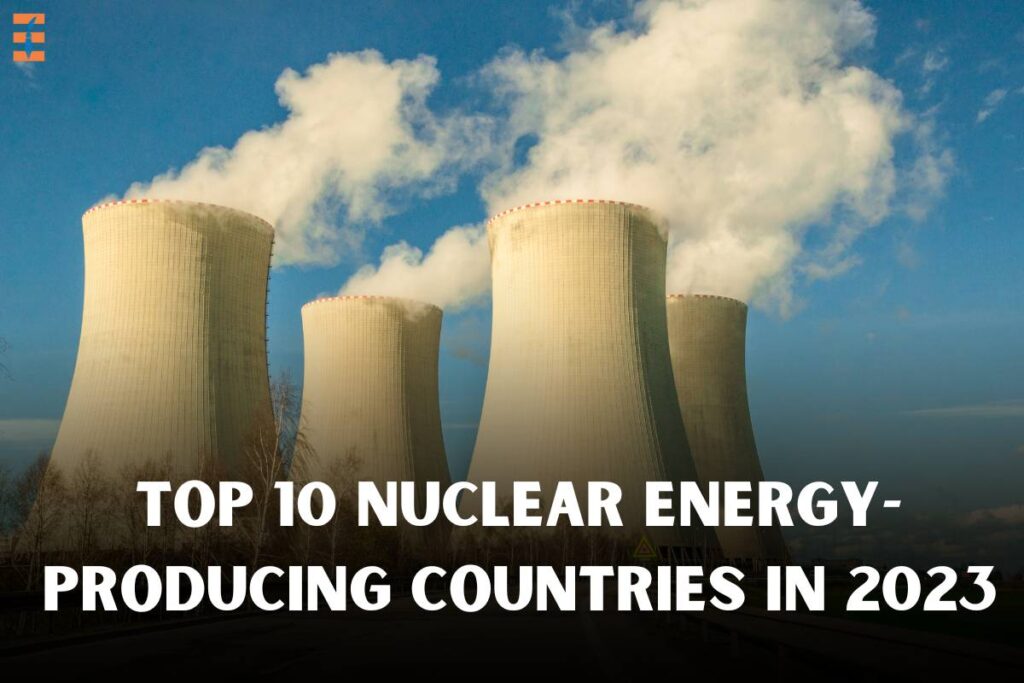Nuclear energy is the form of energy released from the nucleus, the core of atoms made up of protons and neutrons. The nuclear energy bestowed upon the globe these days is via nuclear fission. Nuclear fission is a reaction of an atom where the nucleus in an atom of uranium-235 is divided into two smaller nuclei. Countries with nuclear energy play an important role in formulating the global energy space. It utilizes advanced technologies and more resources to meet its energy needs or requirements.
As we are into the mid of 2023, it has become necessary to identify the top nations that have excelled in producing nuclear energy to shape their economies and give sustainable power solutions. These countries have shown their zeal to bring about changes in support of the green environment to diversify and save natural resources. This will help rely back on fossil fuels and depict an innovative approach and pioneering spirit.
Mentioning The List Of Top 10 Countries In Nuclear Energy Production:
1. USA:
As most of you know United States of America (USA), is the highest producer of nuclear energy. It shows off the total nuclear energy-producing capacity of 91.5GW which is generated by 93 reactors. These reactors are spread across 30 of the country’s 50 total states. With this capacity, a total of 20% of the country’s total electrical capacity is fulfilled. In 2016, particularly the country was dependent more on coal and gas for this power production. According to reports, the state of Georgia will possess two more of these reactors.
2. France:

France produces almost two-thirds of its total electricity from nuclear sources. It generates a larger share of the energy from any of its counterparts from 56 operational reactors. 338.7TWh was the quantity produced in the year 2020. France has some expertise in this field and seems a pretty old practice there. As the awareness increased, the country generated approximately 17% of its total electricity generation capacity. They plan to build more reactors in the coming years and become a decarbonized company by 2050.
3. China:
With a capacity of 50.8GW, China is the world’s third-largest nuclear energy-producing country. All this energy is produced with the help of 51 nuclear reactors. China aims at opening 18 more reactors to grow its power infrastructure. A whopping 17.2GW would be the total number of power generated in total. Another aim of China is to add 39 more reactors which will go to a gross total of 43GW when calculated collectively. This will mark a day in history for China. Achieving the set target may take some time but it won’t go unplanned and cause chaos. It is a gradual process that will be planned systematically.
4. Japan:
With 33 functioning nuclear reactors, Japan stands its head held high at number 4. The net installed capacity of these reactors is 31.7GW. 2 reactors are under construction and will soon join the tribe. It will increase the existing capacity by 2.6 GW. Post the Fukushima nuclear accident in 2011, a total of 30% of Japan’s nuclear energy was derived from other sources. Currently, Japan imports 90% of its energy needs.
5. Russia:
Russia grabs the number 5 spot, with the possession of 38 reactors having a net capacity of 29.6GW. In the nuclear energy field, Russia is often addressed as the global leader due to the USSR’s industrial striving and efforts. Due to those efforts, Russia grabbed this position and was able to produce 195.5TWh in 2019. That accounted for 19.7% of the total energy generated in the country that year. Two more reactors that are part of the Kursk II project are currently under construction but are in the completion stage almost.
6. South Korea:

Carrying a capacity of 24.5GW, South Korea stands at number 6 with 24 nuclear reactors at hand and operating in full swing. The southeastern part of the country is the major player in demanding higher electricity as the region is mostly filled with manufacturing operations carried out that need heavy electric use. The machines consume a noticeable amount of electricity. The country generated 139TWh of the nuclear space in 2019 deriving a total of 26% of its total capacity.
7. Canada:
Canada has 19 operational nuclear reactors that are spread across 4 power plants. It makes a total capacity of 13.6GW of net installed capacity. In 2019, Canada generated 94.9%TWh of nuclear energy which was over 14.9% of the total country’s requirement. The Canadian Deuterium-Uranium is used by all power plants which use Uranium as fuel and repressurized by heavy water reactors. It both acts as a coolant and a moderator.
8. Ukraine:
Ukraine comes at number 8 on the list with a combined capacity of 13.1GW with 15 operable reactors. In Ukraine too, 2 reactors are under construction (Khmelnytskyi 3 & 4) as the water reactors are heavy with a capacity of 2GW net capacity. In 2019, Ukraine manufactured a total of 78.1TWh of nuclear energy, which was enough for 53.9% of the total country’s consumption. The country is purchasing fuel from US-based Westinghouse due to the geopolitical instability prevailing, so they need not depend much on Russian nuclear fuel and services.
9. UK:
UK at number 9, has a combined net nuclear fuel capacity of 8.9GW from 13 functioning nuclear reactors. In 2019, the country produced a total of 51TWh of nuclear energy amounting to 15.6% of total country’s requirement. Two new reactors, namely, Hinkley Point C1 and Hinkley Point C2, are expected to launch in June of 2027. This will supply low-carbon electricity to 6 million homes. By 2035, almost more than half of the nuclear reactors will be discarded.
10. Spain:

Overtaking Sweden for the number 10 spot, nuclear fuel totally accounts for 22% of Spain’s electric consumption. Generated by seven reactors, the country has an installed capacity of 7.1 GW. Nuclear fuel is necessary for Spain currently so the restrictions on the production of the fuel have been lifted by the ministers for their operational lifespans. In the years 2020 and 2021, out of seven, six of the reactors got a renewed license to function further. Before 2035, all these would expire which is the deadline of the Spanish government’s planned phaseout of the year.
Conclusion:
We hope this article provided valuable insights on a knowledgeable topic like nuclear energy. Let’s all of us take the pledge to save the environment on a global level. By mentioning the top 10 countries, we wanted to spread awareness of the use of nuclear fuel and the benefits attached to them. Updations in the nuclear fuel space are nothing new. We constantly need to stay in touch with the new trends in the market of the same and act accordingly to save the environment from getting spoilt.
Also Read: Gov. Green Signs Legislation To Upgrade School Infrastructure And Curriculum










